Aventon Sinch 2.5 Review | Functional Folding With Upgrades
Whether you stash it in a closet or stow it in an RV, this folding e-bike delivers a fun, comfortable, and easy ride.
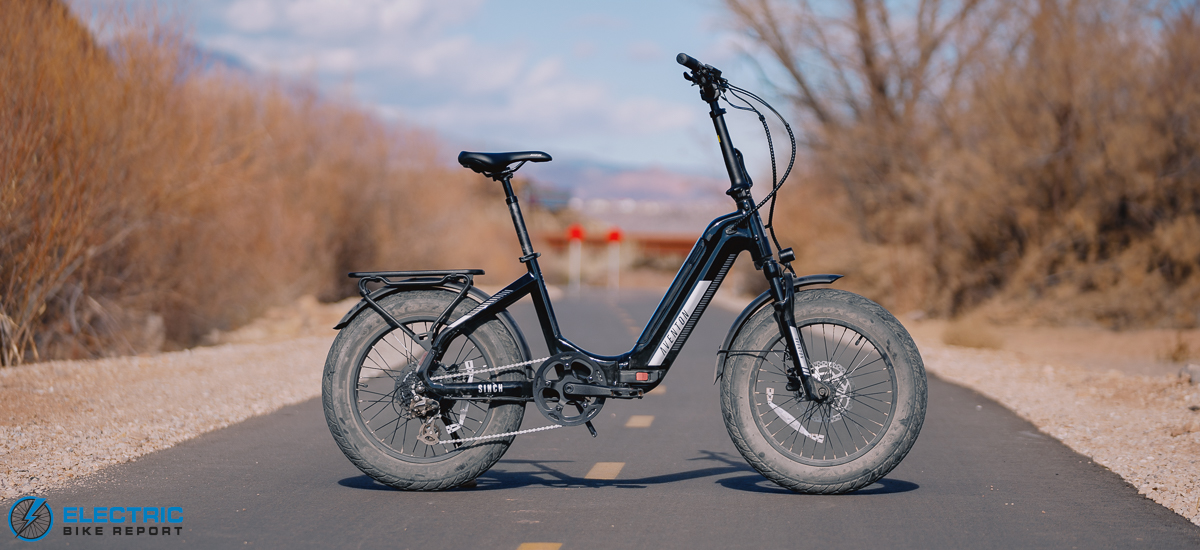
Like its predecessor, the Sinch.2 (which we reviewed roughly two years before the 2.5), the Aventon Sinch 2.5 seems to prioritize being a good bike first, with its folding aspect taking a backseat.
So, what’s different about this newer version of the bike? And why isn’t it called the Sinch.3?
Aventon kept the same frame design (with two refreshed color options, Midnight Black and Sage Green) while making a few minor but impactful changes to components and programming.
The Sinch.2 was specced with mechanical disc brakes, a custom derailleur and combination shifter/throttle lever, and Aventon’s standard, full-size color display. The Sinch 2.5 now features hydraulic disc brakes, a left-hand throttle, a Shimano-branded shifter/drivetrain, slightly chunkier 20×4 tires, and a small handlebar-mounted display/control panel.
With the same frame, motor, and battery, we expected that the Sinch 2.5 would share much of the Sinch.2’s performance characteristics. We quickly learned that along with its new display, the bike’s programming also got an update. See our full review below to learn how this influenced the results of our series of standardized performance tests!
Class 2 (throttle to 20 mph)
Class 3 (pedal assist to 25 mph)
 Pros
Pros- The bike is powerful! Pedaling is fun and easy thanks to its 500W rear hub motor and highly responsive torque sensor.
- It rides comfortably with 20×4” fat tires, a 50-mm-travel suspension seatpost, and an adjustable coil suspension fork.
- The bike’s 4” fat tires and overall weight of 72.5 lbs help it feel sturdy and stuck to the ground.
- We’re a fan of Aventon’s integrated tech, which includes brake lights, turn signals, and Bluetooth connectivity.
- The Aventon app includes useful features such as ride data tracking, syncing with apps like Strava and Apple Health, maintenance tracking, speed adjustment, and more.
- While the bike’s tires are best for paved surfaces, their tread is grippy enough for quick jaunts across dirt or gravel.
- We’re happy to see the Sinch finally adopt hydraulic disc brakes; previous versions used mechanical disc brakes.
 Cons
Cons- Three of the Sinch 2.5’s four assist levels felt identical in our testing; we encourage Aventon to redistribute the bike’s power levels for greater differentiation.
- Riders on the tall end of the bike’s height range won’t likely have full leg extension. We recommend that Aventon include a longer 350mm seatpost to better accommodate taller riders.
- Battery: Removable Internal Lithium-ion Battery, 48.8V, 14Ah (636.4Wh)
- Display: Aventon BC147
- Motor: 48v, 500w brushless hub motor, 60Nm torque, 750W peak
- Headlight: Integrated
- Taillights:Integrated
- Pedal Assist: 4 Levels
- Claimed Range: Up to 55 Miles
- Throttle:Aventon LH Handlebar Mounted
- App:Aventon App
- UL Certification:UL 2271 Certified, TUV Rheinland Certified in accordance with UL 2849
- Claimed weight: 68 lbs
- Tested Weight: 72.5 lbs
- Rider height range: 4’11” – 6’2″
- Total payload capacity: 300 lbs
- Brakes:Tektro HD-T280 Hydraulic Disc, 180mm front & rear rotors
- Fenders:Included
- Fork:Aventon coil fork with lockout and black stanchions.
- Frame: 6061 Single-Butted Folding Aluminum Alloy with Internal Battery
- Drivetrain: 8 Speed Shimano, 48T Chainring, 12-32T Cassette
- Grips: Aventon glue on grips
- Saddle: Aventon Saddle
- Handlebar: Aluminum 25.4mm diameter, 580mm wide
- Kickstand: Included
- Pedals: Folding platform
- Tires: Innova IA-2579 20×4.0
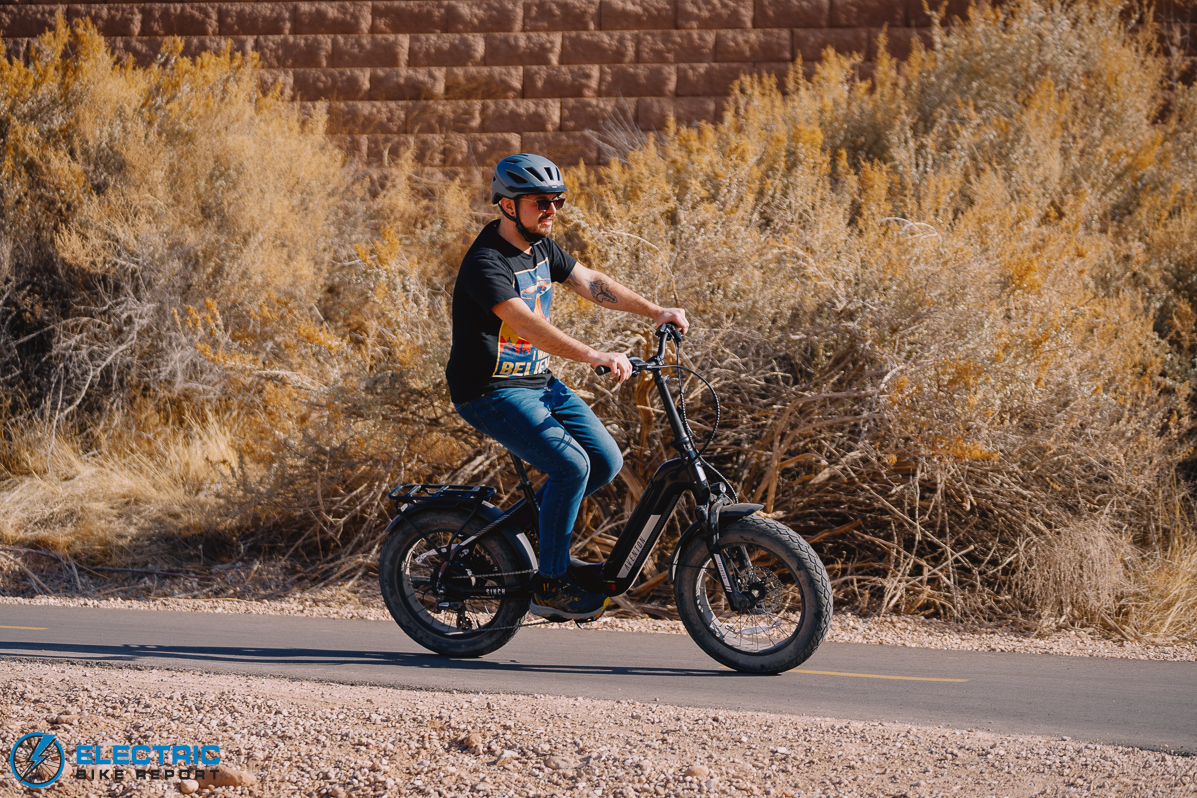
With a responsive torque sensor, the Sinch 2.5 gives you more power when pedaling harder and less power with softer pressure on the pedals
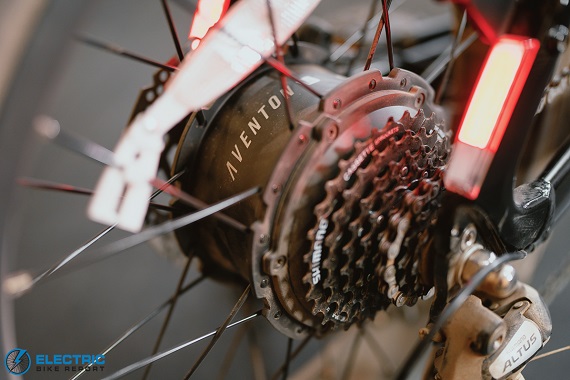
The bike’s capable 500W rear-hub motor provides 60 Nm of torque.
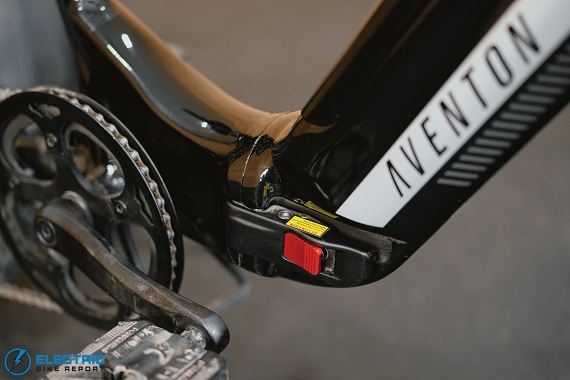
A hinged frame allows the Sinch to fold to the following dimensions: 37” L x 22” W x 31” H.
Aventon Sinch 2.5 Review: Speed Test

The Sinch 2.5 is a Class 2 e-bike with throttle and pedal-assisted speeds up to 20 mph, though users can increase the pedal-assist limit to a maximum of 25 mph (making it a Class 2 and 3) through the Aventon app.
We performed a Speed Test in both modes to ensure it was capable of meeting both maximum speeds. Our goal was also to determine the average speeds of the Sinch’s four levels of pedal assist. To achieve this goal, we rode the bike on a flat segment of the shared-use paths near our office in SW Utah; our results are shown in the graph above.
As indicated by the results of both tests, the bike delivers a significant amount of power even in its lowest pedal assist setting—so much that its three higher levels all reached the 20 mph ceiling in the Class 2 test.
The Class 3 test showed more differentiation between settings with the same initial dose of power in Eco mode. From there, the bike progressed up to its 25 mph limit with small—but fairly even—increments in speed.
With a torque sensor, the Sinch 2.5’s motor can change its output in response to the amount of pressure applied to the pedals, and its pedal assist settings are not limited in speed except at the Class 2 or 3 maximum. As such, it is possible to reach either of these limits even in Eco mode with enough effort applied to the pedals.
When performing our Speed Tests, I maintained a fairly casual level of effort; the bike’s programming and powerful motor made pedaling extremely easy. As it is, however, I didn’t notice much of a difference in feel between Tour, Sport, and Turbo modes, so the bike seemed to have one low-power setting and three high-power settings.
I encourage Aventon to adjust the bike’s programming in the future to better differentiate between all four assist levels. We don’t consider the bike’s current programming to be a deal breaker, though, since adjustments should be possible with an over-the-air update through the Aventon app.
Keep in mind that we’re reporting our experience based on the bike’s programming at the time of writing; an update may have already been released by the time you read it.
Overall, our test showed that the Sinch might benefit from some programming changes, but we liked how responsive it felt. This bike’s torque sensor is highly sensitive, so the motor quickly delivers more or less power to small changes in pedal pressure.
For this reason, we found that it took a bit of practice to keep the ride smooth—consistent pressure and a regular cadence are essential—but after a few rides, it felt like second nature.
Finally, when testing the Sinch 2.5’s throttle, I found that the motor felt strong and steady without being too punchy. Most riders should find the bike controlled and approachable; it felt capable but never seemed out of control.

While the Sinch 2.5 is best suited to riding on streets and paved bike paths, we found it plenty capable of handling light dirt and gravel areas, too.
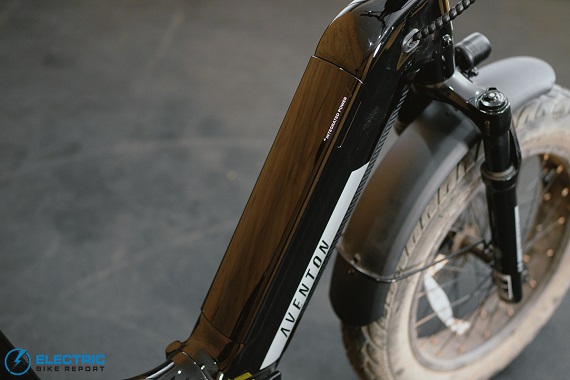
The bike’s 636-Wh battery is fully integrated into the down tube and painted to match the frame.
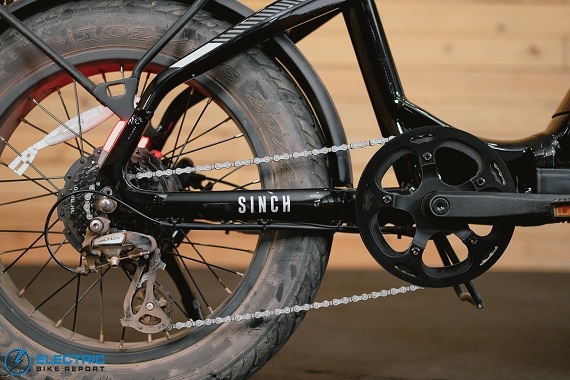
An 8-speed drivetrain has flexibility for tackling hills and picking up speed on flats.
Aventon Sinch 2.5 Review: Range Test

Aventon advertises a range of up to 55 miles for the Sinch 2.5; we tested this claim using the method described above and found it to be accurate. The bike’s results of 34.9 and 55.6 miles are slightly above average when compared to similar folding e-bikes we reviewed with 500W and 750W rear hub motors.
The bikes used for comparison averaged 28.6 miles in their max-assist test and 51.3 miles in their minimum-assist test. The Sinch 2.5 traveled further by about 6 miles in Turbo mode and 4 miles further in Eco mode. These results make sense when considering that the Sinch’s 636-Wh battery capacity is relatively average compared to its competitors (608 Wh).
Most other folding bikes we’ve reviewed used cadence sensors, which tend to be a bit less efficient than those with torque sensors (like the Sinch). As discussed in the Speed Test section, even Eco mode kicks out quite a bit of power, so its programming seemed to balance out any advantage it might have had with its torque sensor.
Earlier, I recommended that Aventon change the programming to differentiate more between its four assist levels; I think it’s fair to think an adjustment could also improve its range.
As it is, the bike exceeded our expectations based on its specs. With a 636-Wh battery and 500W motor, we estimated that its Turbo mode test would yield roughly 21.5 miles over the course of 1 hour and 16 minutes. Its real-world results gave an additional 13+ miles and roughly 50 minutes of ride time.
The roughly 35-57 miles of range from our test should cover a lengthy round-trip commute or, if you’re looking to bring the Sinch with you on your cross-country adventures, a long day of exploring a new city. When it is time to recharge, the bike’s 3-amp fast charger can recharge the battery in a speedy 4.5 hours.
Aventon Sinch 2.5 Review: Hill Test
Motor output is a key factor in this test; the Sinch 2.5’s motor peaks at 750W with 60 Newton-meters (Nm) of torque, both of which are somewhat below average when looking at our pool of similar bikes (940W and 66Nm are average). Additionally, the Sinch is a bit heavier than average, so it exceeded our expectations based on those factors.
Clearly, this bike won’t have any trouble with steep hills, so travelers can feel free to bring it nearly anywhere on their adventures!
Outside of our formal test, I took the Sinch 2.5 to our secondary test hill (called Pilot Hill) to evaluate the power levels of its three highest assist settings. As I explained in the Speed Test section above, the Sinch’s Tour, Sport, and Turbo modes felt nearly identical and also gave us identical results in our Class 2 Speed Test.
At Pilot Hill, I finished my Turbo mode test in 1:16 at 14.9 mph. My Tour and Sport Mode results were identical at 1:19 and 14.3 mph. With only a handful of seconds between those results—which is well within the margin of error—the data backs up my sense that there was not much (if any) measurable difference in power between those three settings.
Regardless, this bike proved that it can effectively help riders pedal uphill, but it also gives them the option to throttle, letting the motor do the work. Whether you prefer a relaxed or active experience, the SInch 2.5 can accommodate you!
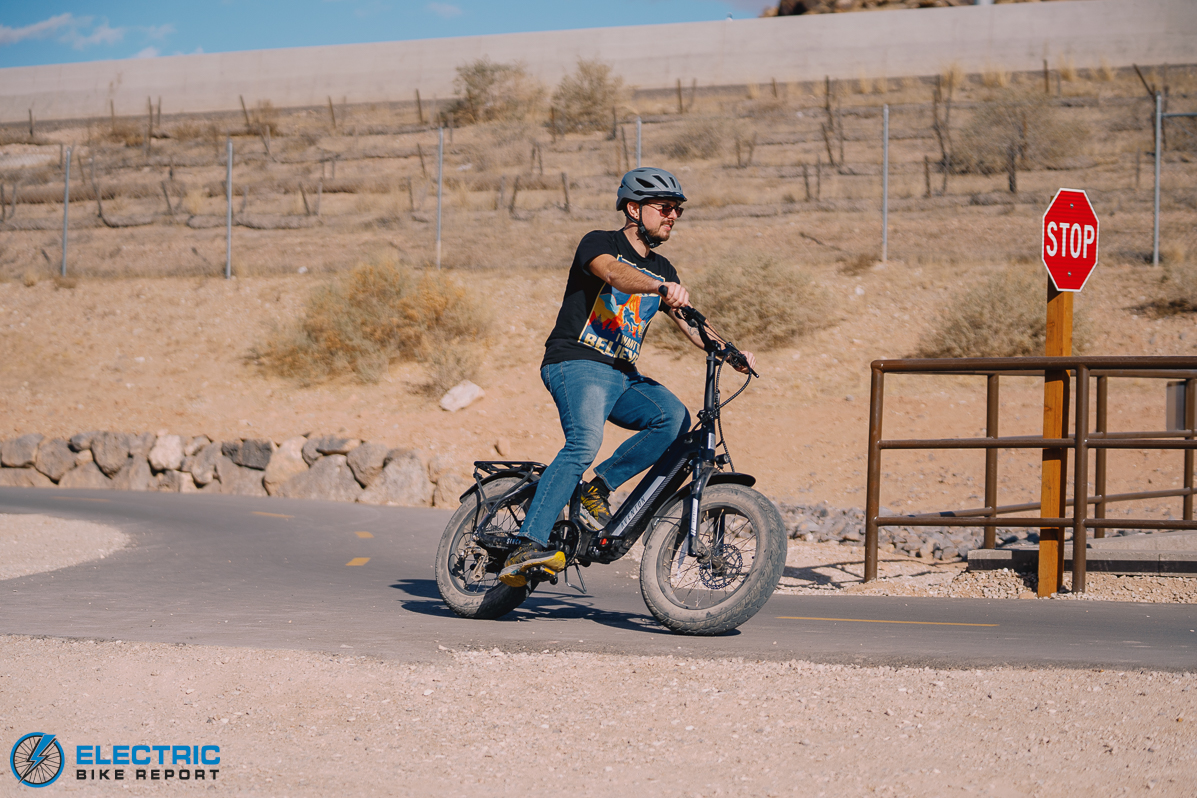
Cornering feels stable thanks to the Sinch 2.5’s 4-inch-wide fat tires and overall weight.
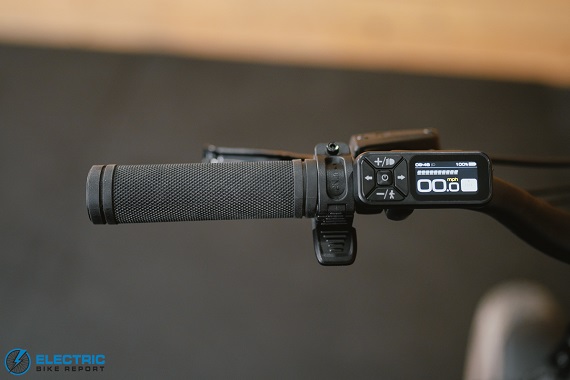
The throttle lever and control panel are within easy reach of the textured rubber grips.
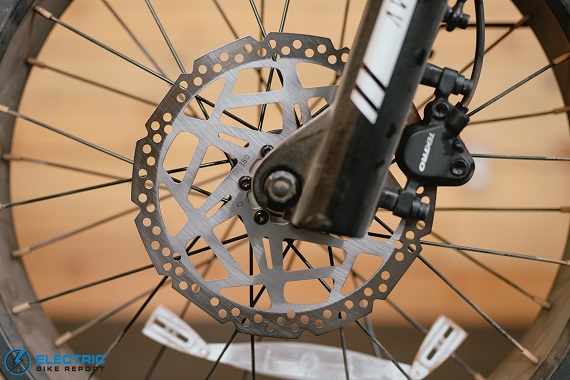
Tektro hydraulic disc brakes with 180mm rotors provide ample stopping power.
Aventon Sinch 2.5 Review: Brake Test

Using this method, we determined the Sinch 2.5’s average stopping distance to be 21’6”. This result falls well within our range of expectations, though it slightly exceeded the folding e-bike category average of 20’8.
Like many of its competitors, the Sinch is equipped with a hydraulic disc brake system with 2-piston calipers and 180mm rotors; Aventon specced it with the Tektro HD-T280 system. One noteworthy feature is that this system does not include a motor cutoff feature, meaning that the brakes can be used to modulate speed while pedaling with motor assistance.
Other folding e-bikes we used for comparison averaged roughly 67 pounds, while the Sinch 2.5 weighs nearly 73 lbs, including a 7-lb battery. With more weight and a relatively standard brake system, the Sinch 2.5 performed well despite being slightly more difficult than average to slow down.
In my time on the Sinch, I thought its brakes felt great. As hydraulic brakes, the brake levers did not require much force to slow the bike down. The system responded quickly, and it seemed to be well-matched to the Sinch’s speeds.
Based on the bike’s feel and performance here, we consider it to be specced well with safe and effective brakes.
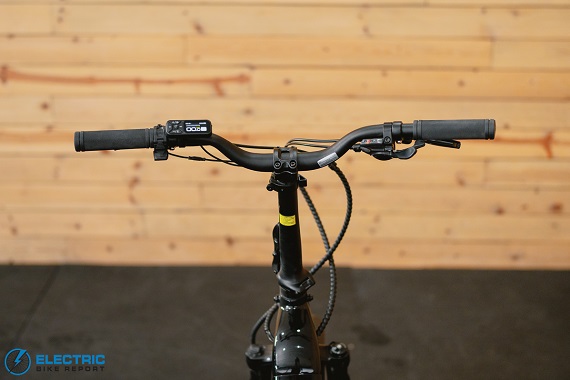
The bike’s 580-mm handlebars are mounted to a telescoping stem.
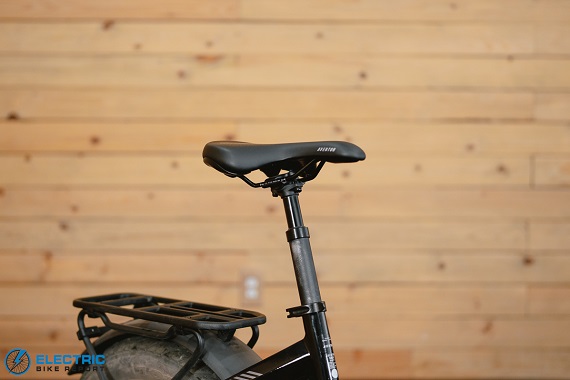
A custom saddle is mounted to a suspension seatpost with 50mm of travel.
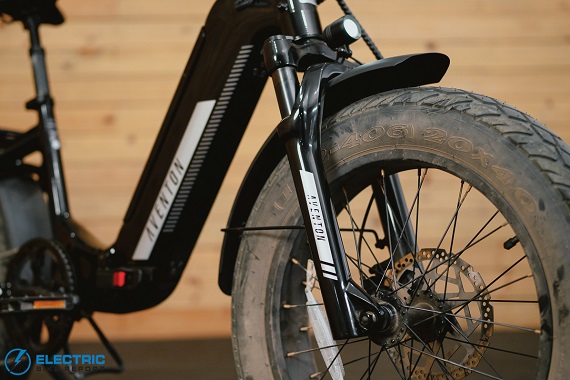
The coil suspension fork provides 50mm of travel to absorb bumps & dips in the road.
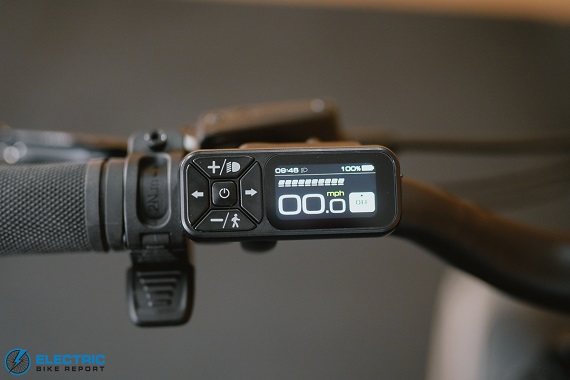
The small color display shows speed, power level, battery charge, PAS setting, and more.
Aventon Sinch 2.5 Review: Ride Quality
Some of the Sinch’s defining characteristics are its stability and sturdiness; its 20×4” fat tires provide a wide platform to cruise on, while its stout frame and above-average weight help it to feel solid and stuck to the road. With such small wheels, it is highly maneuverable, but its weight also helps to outweigh the twitchy handling that is common with folding e-bikes.
The Sinch 2.5 is sold in a single frame size advertised for riders between 4’11” and 6’2”. At 5’11”, I thought its sizing generally felt appropriate—its reach was neither cramped nor excessively stretched, and it includes a telescoping stem for handlebar height adjustment. With that in mind, taller riders will likely find the 6” of saddle height adjustment fairly limiting.
Among the Sinch 2.5’s upgrades is a suspension seatpost that, in combination with the coil suspension fork with 50mm travel, helps to smooth and cushion the ride. We appreciated the added comfort of the 250mm seatpost, but we recommend that Aventon spec the bike with a longer 350mm seatpost to provide better leg extension for those around 6’ tall.
Tires are another upgrade on this refreshed version of the bike. I found the Sinch.2’s smoother tan-wall tires to be relatively slippery on unpaved surfaces. In contrast, the 2.5’s street tires have a slightly more aggressive tread that, in my experience, performed better when riding over short gravel and dirt areas.
Continuing with new features, I liked the small handlebar-mounted display. Color-coded assist settings made it easy to know which mode the bike was currently in. The turn signal buttons were within quick reach of the grip, and the screen displayed all essential ride data, though I found the battery charge percentage rather small and tough to read while moving.
In previous sections, I mentioned that the bike’s speeds can be adjusted through the Aventon app. The app also allows users to track ride data (manually or automatically); it uses this data to suggest maintenance needs but can also sync with Strava and Apple Health. Users can also interact with a community of other Aventon e-bike owners.
When folding the bike, the Sinch lived up to the ease suggested by its name. It features a hinge mechanism built into its frame, as well as a collapsible stem and folding pedals—all of which are of relatively common design. We found the central hinge somewhat stiff but plenty secure and sturdy. When folded, the bike measured 37” L x 22” W x 31” H.
Overall, the Sinch 2.5 delivered comfort, responsive steering & motor engagement, an effective user interface, and a useful app. Those planning to fold/transport/store the bike regularly may find its weight cumbersome, but as I mentioned early on, the Sinch seems to prioritize being a good bike first, with its folding aspect being more of a secondary feature.
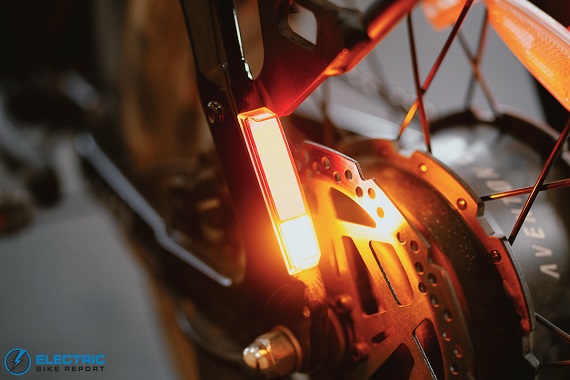
Brake lights and turn signals are integrated into the Sinch 2.5’s seat stays.
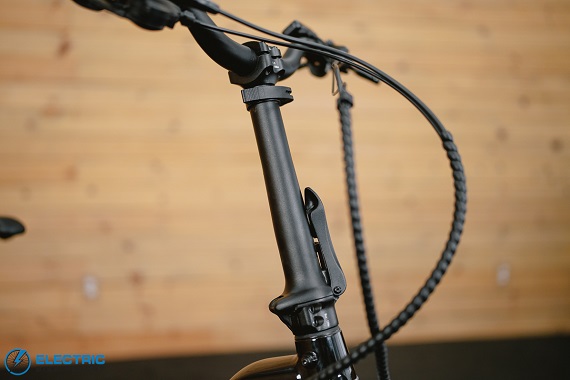
A collapsible stem allows the handlebars to fold down, reducing the bike’s overall height.
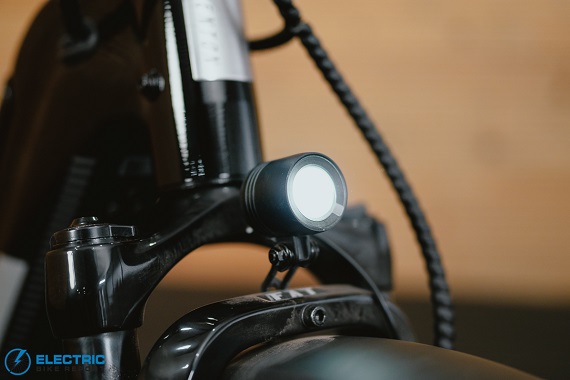
A small integrated LED headlight is mounted to the bike’s suspension fork.
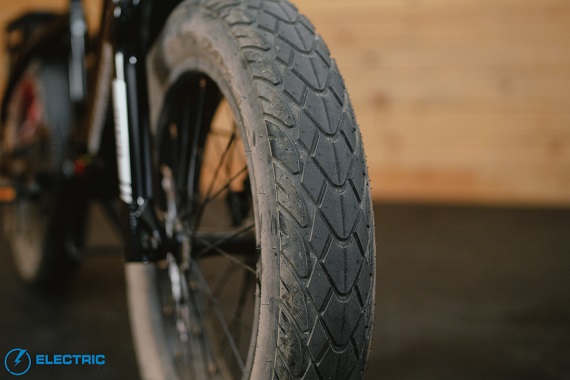
The Sinch’s 20×4” fat tires are stable and provide traction on paved or unpaved surfaces.
Aventon Sinch 2.5 Review: Summary / Where to Buy
With refreshed color options and a handful of upgrades to its components and ride quality, the Sinch 2.5 is a worthy half-step forward for Aventon. We appreciated its highly responsive torque sensor, its powerful motor, its full suspension, and its integrated technology.
These features set the Sinch apart in a relatively crowded market—plus, as an Aventon e-bike, it benefits from generally being well-put-together.
We identified two main areas with room for improvement. First, an over-the-air update that better balances the bike’s pedal assist settings would make its four power levels more meaningful. Second, a longer suspension seatpost would make pedaling the Sinch more comfortable for riders on the taller side.
Considering that both of these points are relatively easy to correct, we do not consider either to be a deal breaker—they’d just take a highly functional e-bike from good to great. As it is, we’re solidly satisfied with the Sinch 2.5’s range, its stopping power, and its climbing ability.
We recommend this bike for riders seeking a fun and easy way to ride around town, get to work or school, or simply spend a bit more leisure time outside. Regardless of what the Sinch 2.5 is used for, we’re confident it will do the job well—the fact that it can be folded for storage or easier transport is the icing on the cake!
Happy Riding! Make sure to let us know if you have any questions or if you think we left anything out in this review of the Aventon Sinch 2.5 down in our comments section.


